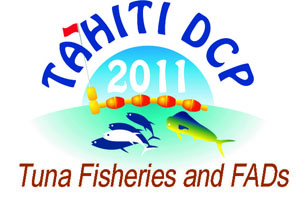Status of FADs in Solomon Islands
1 : Ministry of Fisheries and Marine Resources
(MFMR)
P. O. Box G13, Honiara, Solomon Islands -
Îles Salomon
Solomon Islands, with the current trend of inshore marine resources exploitation, their primary source of diet protein will become scarce. With a majority of Solomon Islanders living in rural and coastal communities, some communities are faced with potential hardship from declining fish supply in years to come. FADs were introduced to the Solomon Islands by Solomon Tayio Co. Ltd as early as 1973 to support their fleet of pole & line boats. NFD (National Fisheries Development) Co. Ltd started in 1984 with pole & line boats and two purse seiners. FAD design with 16mm pp rope, 2/3 concrete drum anchor and bamboo raft, NFD 250, STL 110 FADs. The national inshore FAD program was identified by the Solomon Islands government as part of the Ministry of Fisheries and Marine Resources(MFMR) Inshore Fisheries Strategy as a medium term goal to deploy FADs as part of CBRM activities. From March up to September 2011, a total of 15 FADs deployed and 5 had been lost due to sabotage/vandalism within 2 - 4 weeks after deployment. In Malaita province, with community initiatives, materials were acquired through their MPs, provincial fisheries staff helped to rig and deploy 10 FADs within the last 3 years but have lost 2. All FADs are nearshore, surface, moored FADs while 2 in Marovo and 1 in Langalanga are lagoon FADs. Fishing techniques used - Solomon Tayio & NFD – Pole & line and Purse-seining Community fishermen - Trolling, Drop stone, Jigging Main species caught – Yellowfin tuna, Skipjack tuna, Bigeye tuna and Albacore tuna while Community fishermen target all pelagic species that are edible and valuable. Monitoring, maintenance and data collection (catch) is undertaken by the WorldFish Center in collaboration with MFMR staff, PFOs and CBRM partners. The purpose of the FADs is for food security, income generation and fishing diversification. The FAD program is managed by a steering committee comprising of WorldFish and MFMR staff, is funded by NZaid, deployed by WorldFish and MFMR staff, while monitoring is done By WorldFish, MFMR and CBRM partners. Fishermen do FAD observational monitoring. The program is for 3 years (2011-2013).

 PDF version
PDF version
